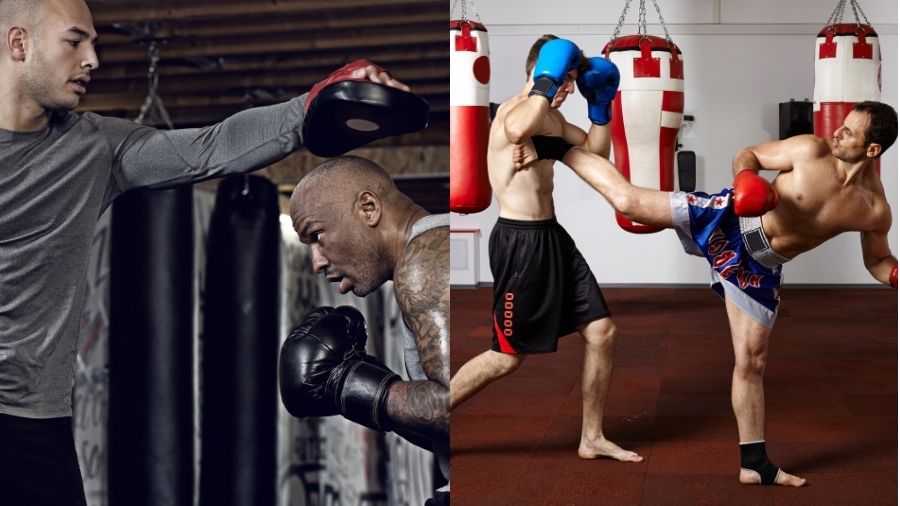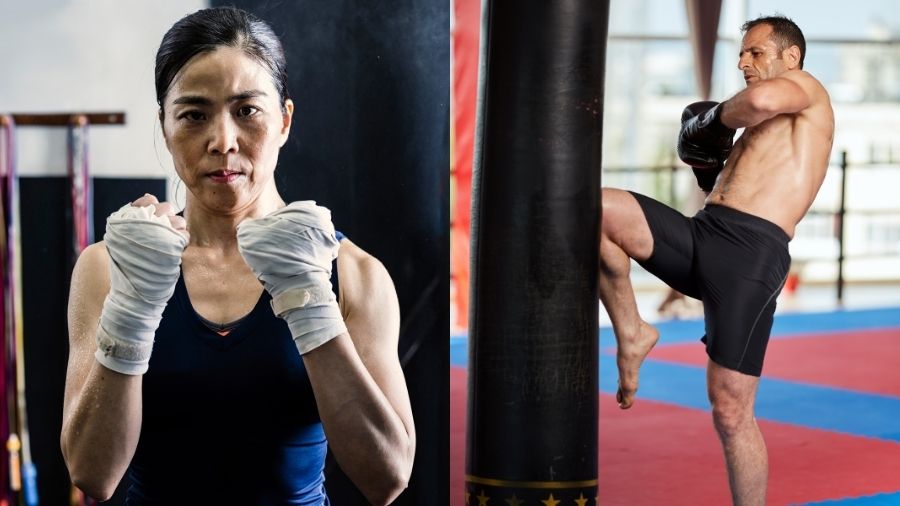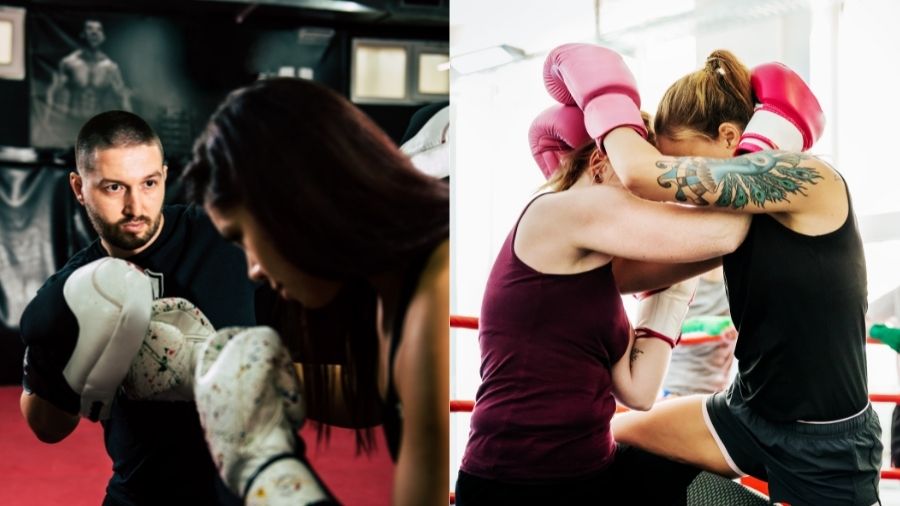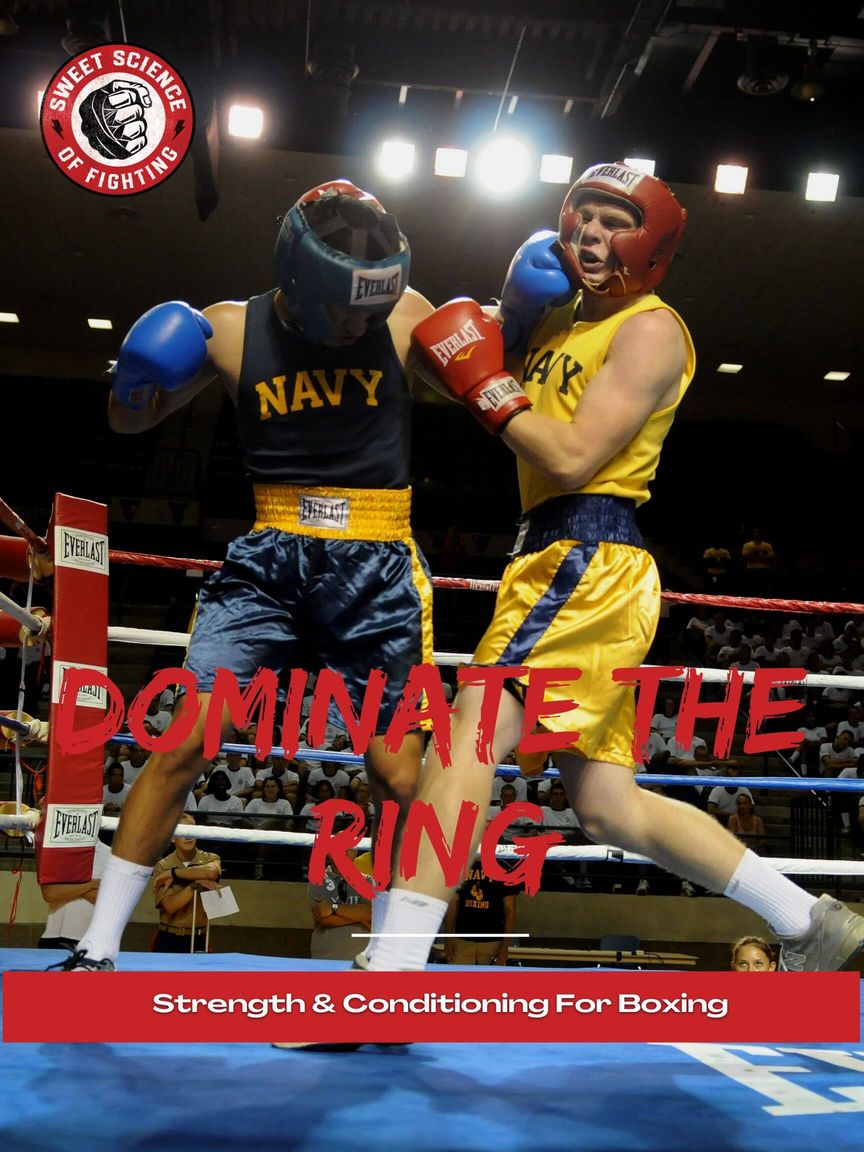Boxing and kickboxing are two of the premier combat sports in both efficacy and popularity. They are quite similar, with the big difference being that boxing only allows punches. In kickboxing, both punches and kicks are allowed. The question of which style will win has been asked numerous times and has been practically answered quite a few times.
The result is that kickboxing wins a one-on-one fight with boxing due to its wider variety of techniques. The kickboxer keeps their distance and uses longer-ranged kicks to slow down and eventually finish the boxer.
With that said, the result can’t always be identical, and the outcome depends on the individual as on the style. Of course, there is a great deal more to both sports than just pure confrontation between them. So it’s well worth it to look closer at both and showcase their many advantages and how they compare to each other.
What Is Boxing?
Boxing is the most popular combat sport as it’s been around the longest (sorry if you are a wrestler, but boxing has tons more popularity and fans over the last at least 150 years). We have evidence of fist fighting dating to around 3000 BC, and it’s well documented that a form of boxing was an essential part of the greatest sporting event of antiquity- the Olympics.
Modern boxing came about in the 17th century in England. Its current form was largely finalized by the unified rules published in 1867 under the patronage of the Marquess of Queensbury.
Discover The Little Known Secrets For Unlocking Devastating KO Power!
Heavy hands are built doing these things...
Because only punches to targets from the waist up are allowed in boxing, fighters have to develop different ways to open up the opponent and penetrate their defense. This makes footwork, distance management, and head movement pivotal in boxing fights.
Boxing is often called the “sweet science” for its subtle nuances and tactics that often elude the uneducated viewers but attract many lifelong fans of the sport.
What Is Kickboxing?
As the name indicates, kickboxing is a combination of punches and kicks. It’s an umbrella term covering a wide variety of styles and rules. In kickboxing, punches, kicks, and knees are allowed, but elbows are prohibited.
The emphasis on the sport is fast-paced stand-up battles. Clinches are only allowed for a very brief period. Inactivity and passivity are frowned upon and can even be officially penalized by the judges.
The history of the sport has two distinct branches. The first emerged from Muay Thai, which incorporated techniques and elements from western boxing in the 1920s, such as boxing gloves, rounds, and the square ring.
The other side of kickboxing development started in Japan and karate. Kyokushin karatekas fought Muay Thai fighters in the 1960s. The result was a style that merged techniques from both martial arts.
A unified version of kickboxing developed in the 1990s with the birth of K-1. Today all major promotions like Glory and ONE Championship use the unified rules adopted in the K-1 golden era.
For the rest of the article, we will view kickboxing only as “K-1 kickboxing,” which is full contact, stand up fighting at its finest. Other styles include point kickboxing, light contact, and even cardio kickboxing. Still, they have less to do with combat, and direct comparisons with boxing in terms of effectiveness are pointless.
Key Differences Between Boxing and Kickboxing

It’s time to look at the critical differences between boxing and kickboxing in a few important areas.
Rules
Boxing has two main rulesets- amateur and professional. All bouts are contested in a square ring with 3-minute rounds and 1-minute rest in between. Amateur matches are three rounds, and the volume and accuracy of punches are the main goals. Usually, the judges decide the winner based on who landed more punches. Knockdowns are allowed, but not the primary objective.
The preferred outcome is the knockout in professional boxing, so more emphasis is put on power and damage. Matches are much longer, ranging from 4 to 12 rounds for championship fights.
In a boxing ring, kickboxing fights are also fought in 3 or 5 3-minute rounds with 1-minute rests.
The scoring is taken directly from boxing, and each round is scored individually on a 10-point must system. Still, forward-thinking organizations like ONE FC are trying to break out of this mold and score the fights in their entirety. Arguably more suitable for the shorter kickboxing matches.
The knockout is still the most desired outcome of the fight, and damage and aggression are always rewarded.
Punches, every kind of kick, and knees are permitted in kickboxing, and only elbows are forbidden. Clinches are very short, and no striking is allowed in the clinch, which is the most significant difference between kickboxing and Muay Thai.
Equipment
Both boxing and kickboxing competitions are done with boxing gloves and shorts. Mouthguards are mandatory (I doubt that someone would choose not to wear one anyway).
Boxers use special lightweight shoes that help with traction and stability on the ring. Kickboxers fight barefoot because of the kicks, but ankle wraps with thin shin protection can often be used even by top fighters.
You will need a few more protective pieces of gear like shin guards and knee pads if you spar kickboxing for the gym. But the padded kickboxing gloves, shorts, hand wraps, and other accessories, in the words of the famous UFC commentator Bill Goldberg, are virtually identical between boxing and kickboxing.
Techniques
The addition of kicks makes kickboxing quite different than boxing. However, the punches and the ways to defend them are precisely the same. Kickboxing borrowed them from boxing and then added the kicking game.
Kickboxing rules allow for all kinds of kicks. Various specialists from taekwondo and karate, for example, managed to use unorthodox strikes with great success.
But the vast majority of fighters rely on the kicking arsenal taken from muay Thai-front kicks and heavy roundhouse kicks to the legs, body, and head.
Many boxers prefer evasion as a means of defense and rely heavily on head movement. Most of it is transferable to kickboxing, but the kicks and knees make the deep dives and the overall low position of the head very dangerous.
So the spectacular evasive movements boxing is known for should be used with caution when kicks are present in the equation.
Stance
Kickboxers need to defend kicks that change the standard lead foot heavy boxing stance.
Footwork
The legs provide strikes from much longer distances than the arms, which changes the whole range of the fight. With punches above the waist being the only weapon to open up the opponent, boxers have to find ways to attack successfully.
This is why footwork in boxing is more important. You always need to try and acquire a more advantageous angle to the opponent. The complexity of boxing movement is greater than the punching itself.
Kickboxers tend to use less sophisticated footwork first because the legs become both a weapon and a target. Second, they have more techniques to spend time on and can’t focus on any single aspect of the game.
The long range of kicks changes the overall distance the matches are fought. Usually, the fighters are at a greater distance when they are in a neutral position, and they have to learn to get in and out of range quickly. This makes strikes like the superman punch relatively common in kickboxing and almost nonexistent in boxing.
Boxing vs. Kickboxing for Self Defense

Both boxing and kickboxing will give you a considerable advantage over an untrained assailant, that’s certain. Any martial arts that conditions your body, mind, and reflexes to impact and violence will benefit self-defense. But always remind yourself that a real fight is not a ring contest, and there are no rules.
Kickboxing indeed gives you a more diverse arsenal by teaching you how to kick and defend kicks, and this is an excellent advantage on the street. But kicks are also more dangerous to throw because you can slip or use the kick for a takedown.
Using the hands to quickly and efficiently deal with an attacker and remove yourself from further danger is always a sound tactic. And nothing will teach you to do that better than boxing.
Both have one significant disadvantage, and that is grappling. A quick search through YouTube will show you that many real-life fights end up on the ground, or at least in the clinch.
Both martial arts are lacking in that department. Still, kickboxing has at least a limited form of clinching, which is better than nothing for self-defense. But in any case, if you want to be better prepared to defend yourself, spend some time grappling and wrestling separate from your pure boxing and kickboxing training.
Boxing vs. Kickboxing for MMA

Again the versatility of kickboxing gives it the edge over boxing. MMA encompasses all aspects of unarmed martial arts, so the style that allows for more techniques will naturally be a better fit. Kickboxing footwork is more similar to MMA footwork because of the kicks, but the addition of takedowns changes that even further.
Kickboxing may be better on paper, but this doesn’t mean that boxing doesn’t lend its skills to the cage. Accomplished boxers like former UFC heavyweight champion Junior Dos Santos and current bantamweight king Peter Yan use a very boxing-heavy style that few opponents have managed to find an answer for.
The transfer of skills from specific martial arts depends more on the individual fighter than on the style itself. Every style (not looking at you aikido) can work in MMA if the right adjustments are made.
Is Boxing Harder Than Kickboxing?
I don’t think any of the two sports is harder than the other. In kickboxing, you have more techniques to learn and master, but the more limited rules of boxing mean the level of the allowed techniques will be much higher.
When the main goal is to damage the opponent to the point where he can’t or won’t continue to fight, you will inevitably have to endure pain and injuries.
Science has proven that repeated head trauma is the worst of them. With fewer eligible targets, boxing is more dangerous.
Another rarely talked about topic is the level of competition. Boxing is by far the oldest of the two disciplines. Boxing is rooted in rich traditions, and the prize money and fame are still unrivaled by any other combat sport.
As such, it attracts more competitors, and the overall level is much higher. So if we are to answer which sport is harder to climb to the top, the winner is boxing.
Boxing vs. Kickboxing: Who Would Win?
There have been many fights pitting a boxer and kickboxer against one another, and the winner usually is the kickboxer. When he keeps his distance and uses his legs, the boxer always has a hard time finding answers to the debilitating low and destructive high kicks.
Of course, no two fights are the same, and different fighters try to use different game plans. In the K-1 glory days, there were a few kickboxing rules matches between a pure Boxer and a kickboxer, and here you can see how some of them went:
Is It Better To Learn Boxing Or Kickboxing?
Both boxing and kickboxing are great combat sports that have their advantages. Kickboxing should be your primary choice if you want to be more diverse and have more skills to rely on for self-defense and MMA.
Boxing is a combat sport with very rich traditions and an inseparable part of mainstream sports for a reason, so you will definitely not be wrong in choosing the pugilistic path.
12 Weeks To Knockout Power!
Train like a professional boxer, develop knockout power, and dominate the ring!



